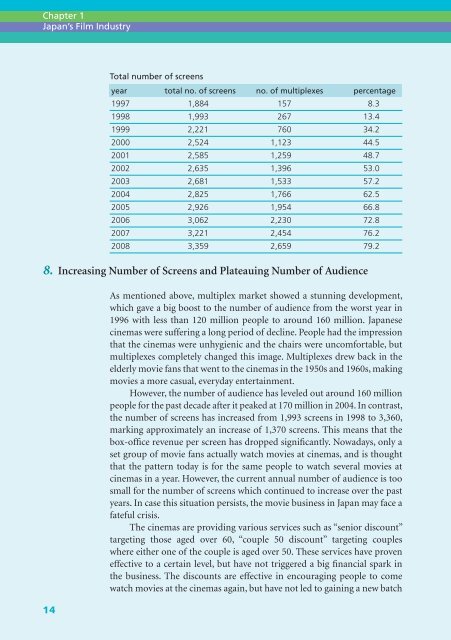The Guide to Japanese Film Industry & Co -Production - UNIJAPAN
The Guide to Japanese Film Industry & Co -Production - UNIJAPAN
The Guide to Japanese Film Industry & Co -Production - UNIJAPAN
Create successful ePaper yourself
Turn your PDF publications into a flip-book with our unique Google optimized e-Paper software.
Chapter 1<br />
Japan’s <strong>Film</strong> <strong>Industry</strong> Postwar <strong>Japanese</strong> <strong>Film</strong> <strong>Industry</strong> and Development<br />
Total number of screens<br />
year <strong>to</strong>tal no. of screens no. of multiplexes percentage<br />
1997 1,884 157 8.3<br />
1998 1,993 267 13.4<br />
1999 2,221 760 34.2<br />
2000 2,524 1,123 44.5<br />
2001 2,585 1,259 48.7<br />
2002 2,635 1,396 53.0<br />
2003 2,681 1,533 57.2<br />
2004 2,825 1,766 62.5<br />
2005 2,926 1,954 66.8<br />
2006 3,062 2,230 72.8<br />
2007 3,221 2,454 76.2<br />
2008 3,359 2,659 79.2<br />
8. Increasing Number of Screens and Plateauing Number of Audience<br />
As mentioned above, multiplex market showed a stunning development,<br />
which gave a big boost <strong>to</strong> the number of audience from the worst year in<br />
1996 with less than 120 million people <strong>to</strong> around 160 million. <strong>Japanese</strong><br />
cinemas were suffering a long period of decline. People had the impression<br />
that the cinemas were unhygienic and the chairs were uncomfortable, but<br />
multiplexes completely changed this image. Multiplexes drew back in the<br />
elderly movie fans that went <strong>to</strong> the cinemas in the 1950s and 1960s, making<br />
movies a more casual, everyday entertainment.<br />
However, the number of audience has leveled out around 160 million<br />
people for the past decade after it peaked at 170 million in 2004. In contrast,<br />
the number of screens has increased from 1,993 screens in 1998 <strong>to</strong> 3,360,<br />
marking approximately an increase of 1,370 screens. This means that the<br />
box-office revenue per screen has dropped significantly. Nowadays, only a<br />
set group of movie fans actually watch movies at cinemas, and is thought<br />
that the pattern <strong>to</strong>day is for the same people <strong>to</strong> watch several movies at<br />
cinemas in a year. However, the current annual number of audience is <strong>to</strong>o<br />
small for the number of screens which continued <strong>to</strong> increase over the past<br />
years. In case this situation persists, the movie business in Japan may face a<br />
fateful crisis.<br />
<strong>The</strong> cinemas are providing various services such as “senior discount”<br />
targeting those aged over 60, “couple 50 discount” targeting couples<br />
where either one of the couple is aged over 50. <strong>The</strong>se services have proven<br />
effective <strong>to</strong> a certain level, but have not triggered a big financial spark in<br />
the business. <strong>The</strong> discounts are effective in encouraging people <strong>to</strong> come<br />
watch movies at the cinemas again, but have not led <strong>to</strong> gaining a new batch<br />
of movie-goers. In particular, the tendency of the younger generations<br />
not going <strong>to</strong> cinemas have been pointed out, and <strong>to</strong> make these younger<br />
generations get in the habit of watching movies at the cinemas has become<br />
an important agenda. This issue cannot be solved by the cinemas alone. It is<br />
an act of protecting the <strong>Japanese</strong> film culture, thus is an issue that the entire<br />
film industry, municipalities and education related ministries and agencies<br />
must tackle <strong>to</strong>gether.<br />
9. TV Networks Entering the <strong>Film</strong> <strong>Industry</strong><br />
In 1998, Bayside Shakedown (Odoru daisosasen: THE MOVIE) produced by<br />
Fuji Television Network recorded a distribution revenue of ¥5.3 billion and<br />
was a big hit with the highest box-office revenue of the year. TV networks<br />
have long been producing theatrical films, with its first work being Steel<br />
Edge of Revenge (Goyokin) by Fuji Television Network in 1969. Since then,<br />
TV networks have been producing many theatrical films such as Antarctica<br />
(Nankyoku monogatari) (1983). <strong>The</strong> film industry was in control and films<br />
were produced mainly by the film related people. However, the involvement<br />
of TV networks drastically changed before and after Bayside Shakedown.<br />
Because Bayside Shakedown was a film adaptation of the TV drama<br />
series, it was produced mainly by the TV network. Ever since, many films<br />
have been produced by the TV networks. Yet these works did not hold<br />
much significance in the film industry. <strong>The</strong>n in 2002, the market share<br />
of <strong>Japanese</strong> films <strong>to</strong>ok a nosedive <strong>to</strong> its worst level at 27%. Since 2003,<br />
however, the market share of <strong>Japanese</strong> films gradually recovered, obtaining<br />
33% in 2003, 37.5% in 2004, 41.3% in 2005 and 53.2% in 2006. In 2006,<br />
the market share of <strong>Japanese</strong> films exceeded that of the imported films for<br />
the first time in 21 years. One of the big fac<strong>to</strong>rs for this recovery was none<br />
other than those films the TV networks were involved in. It is said that TV<br />
networks greatly contributed <strong>to</strong> the recovery of the <strong>Japanese</strong> flm industry<br />
with their keen eyes for spotting what the audience is craving for and the<br />
effective use and influence of information distributed on their broadcasting<br />
networks.<br />
Nowadays, the involvement of the TV networks has become an<br />
essential fac<strong>to</strong>r <strong>to</strong> whether a film will become a hit or not. Yet this move<br />
has not led <strong>to</strong> an increase in the overall number of audience. It was just<br />
that the imported movie-goers simply switched over <strong>to</strong> <strong>Japanese</strong> films. <strong>The</strong><br />
involvement of the TV networks has become a critical fac<strong>to</strong>r when new<br />
proposals are brought in <strong>to</strong> the film companies. As such, excessive influence<br />
of the TV networks has become an obstacle <strong>to</strong> the healthy environment for<br />
fair evaluation of the content of the proposal itself.<br />
14 15




